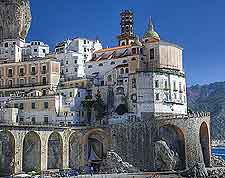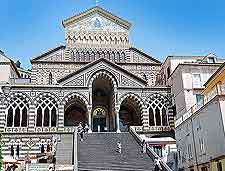Amalfi History Facts and Timeline
(Amalfi, Campania, Italy)

The origins of Amalfi are not certain. Legend has it that Hercules built a city on the exact spot he chose to bury his beloved nymph named Melphe.
Another story, which it has to be said is far more likely, is that a group of shipwrecked Romans settled here in the 4th century AD. They were fleeing Barbarian attacks and were on their way to Constantinople.
In 553 AD, Amalfi was officially ruled by the Byzantine Empire. Then, in the 9th century AD, it declared its autonomy - something that it maintained through to the 11th century. During these earliest years of its history, it is thought that Amalfi came to rival those other two great maritime powers -
Genoa and
Venice. Certainly, in the 10th century, the town was even producing its own currency. Much of St. Andrew's Cathedral dates back to this time.
History in Medieval Times
In 1131, Amalfi was annexed by the Kingdom of Sicily. Its Norman rulers came to dominate the town. Indeed, it never really managed to regain its independence. In 1135 and again in 1137, the town came under attack by Pisan forces, who took advantage of the fact that Amalfi's navy was away fighting the Saracens.
During the 12th century, Amalfi's main activities revolved around paper mills. Its maritime location was also ideal for the trading of grain, salt and silk with Italy, Egypt and Syria. The town's maritime code, known as Tavole Amalfitane, was recognised in the Mediterranean right up until the 16th century.
In 1343, a tidal wave hit the lower parts of the town and Amalfi never fully recovered from the disaster. By the end of the Middle Ages, Amalfi had become part of the powerful Kingdom of Naples. Its king, Ferdinand I, gave the town away as part of his daughter's dowry.

From the 17th Century
Further disaster struck in 1643, when a plague epidemic killed more than 30 percent of the town's overall population. A few years earlier, a landslide had washed away a large part of the town, and so this proved to be an unsettling time in local history. By the 18th century, Amalfi was practically uninhabited, with most of its noble families having moved along the coast to
Naples.
In 1807, Giuseppe Bonaparte (the older brother of Napoleon) visited the area and it is reputed that he was immediately won over by the sheer beauty of its coastline. He therefore decided to construct a road that would extend from Naples all the way to the town of Amalfi. Work on the new road was finally completed in 1854.
In the 20th century, Amalfi became the favoured haunt of the rich and famous, including film directors, artists and actors. In the 1920s and 1930s, in particular, it was popular with upper class tourists from Britain, who were keen to sample 'la dolce vita' for themselves. Today, Amalfi is included in UNESCO's list of World Heritage Sites.
 The origins of Amalfi are not certain. Legend has it that Hercules built a city on the exact spot he chose to bury his beloved nymph named Melphe.
The origins of Amalfi are not certain. Legend has it that Hercules built a city on the exact spot he chose to bury his beloved nymph named Melphe.